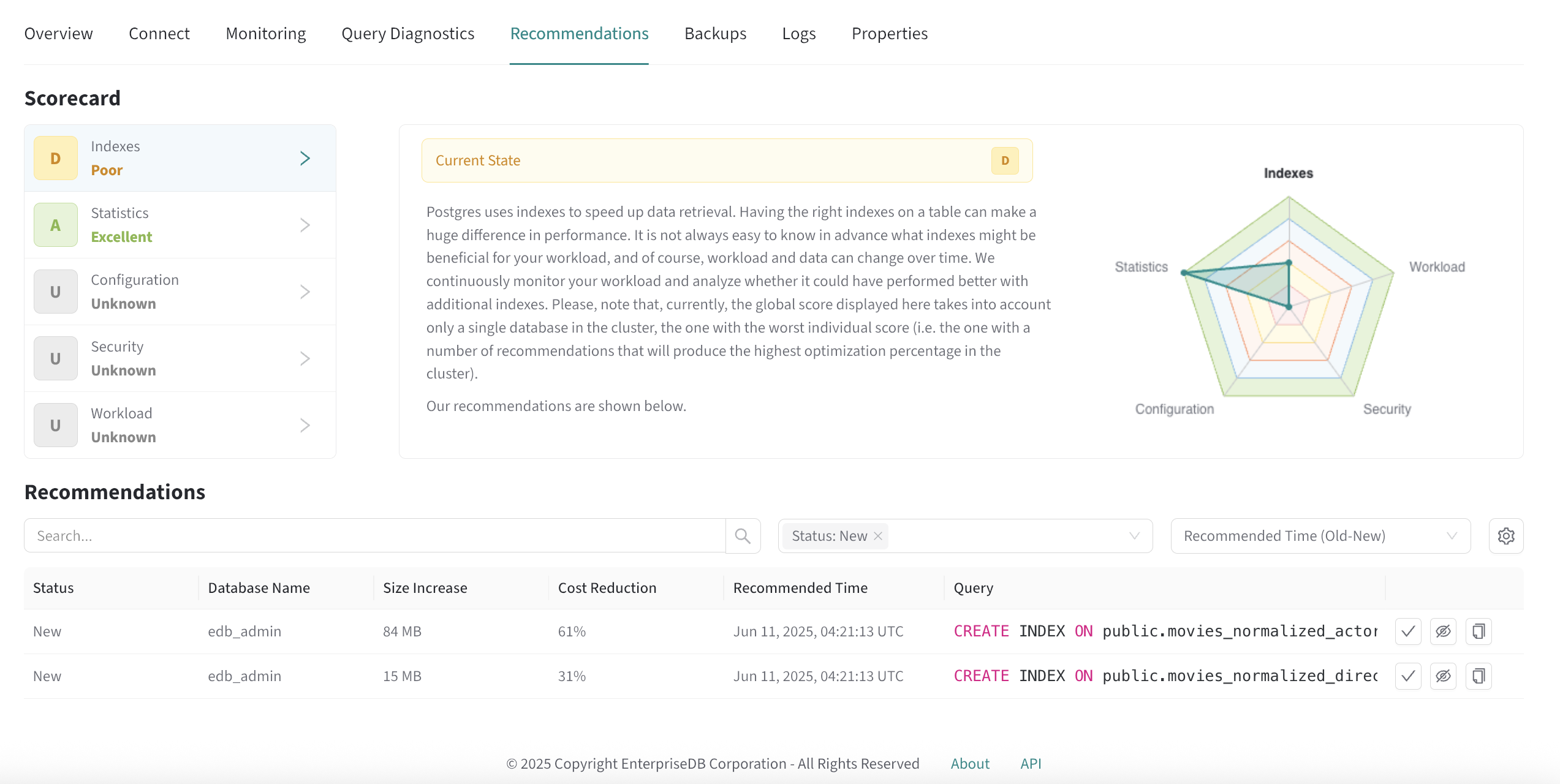Reduce costs and carbon footprint while boosting performance with EDB Postgres AI’s built-in intelligent recommendations.
In the digital-first world we live in, database performance isn't just a technical detail; it's the backbone of customer experience and application success. Slow queries, unresponsive applications, and frequent outages directly impact user satisfaction and can cost businesses millions. The importance and challenge of ensuring peak database performance is escalating. On the other hand, there are growing economic and environmental pressures demanding IT to get more out of existing infrastructure without increasing costs or environmental impact.
The Shifting Landscape of Database Management
Historically, managing complex databases was the domain of highly specialized Database Administrators (DBAs). These experts possessed deep knowledge of database internals, query optimization, and performance tuning. They were the gatekeepers, ensuring stability and efficiency. But the landscape is changing rapidly.
Database environments have exploded in size and complexity, encompassing thousands of databases across diverse infrastructures – on-premises, cloud, and Kubernetes. Simultaneously, the demand for rapid application development has meant that database responsibilities are increasingly being pushed down to individual development teams. Developers are now often tasked with provisioning, designing, tuning, and troubleshooting databases for their specific applications.
This shift creates a significant challenge: while development teams are agile and understand their application needs, they often lack deep database expertise. As highlighted in surveys, more than 50% of current PostgreSQL users have less than 5 years of database experience. Managing databases at scale, especially mission-critical ones, requires specialized knowledge that many developers simply haven't had the opportunity to acquire. Companies reliant on a small number of expert DBAs find these crucial resources stretched thin and overwhelmed by the sheer volume and complexity of the data estate.
The Temptation of "Scaling by Credit Card"
This gap in expertise, particularly prevalent in cloud environments, often leads to a reactive and expensive solution for performance problems: "scaling by credit card". When an application slows down due to inefficient queries or poor database design, the quickest, albeit most costly, fix is often perceived to be simply adding more hardware resources – bigger instances, more memory, faster storage. This provides temporary relief until the workload or inefficiency again saturates the new capacity, leading to another round of expensive upgrades. This cycle is inefficient and unsustainable.
This approach doesn't address the root cause of the performance bottleneck – often inefficient database operations or problematic code. It’s like buying a bigger pipe to handle a clog instead of clearing the obstruction. This reliance on hardware scaling rather than optimization can lead to hundreds of thousands of extra dollars in infrastructure costs annually.
Beyond the financial drain, this constant battle with performance issues takes a significant toll on teams, leading to frustration and burnout. More importantly, it negatively impacts the end-users. Slow load times, delays, and unreliability make customers grumpy and can drive them to competitors.
The Growing Importance of Reducing Carbon Footprint
The pressure to reduce carbon footprint and meet environmental, social, and governance (ESG) goals has never been more intense. All stakeholders, from investors and regulators to customers and employees, increasingly expect organizations to reduce environmental impact. This goes being corporate citizenship; it’s crucial for brand reputation, attracting top talent, securing investments, and meeting evolving global regulations. In response, executives commit to board-level ESG goals that must be met. These goals are difficult to measure and meet with existing tools, but organizations must show how they’re reducing their carbon footprint to achieve and maintain market leadership.
Empowering Teams with EDB's Postgres AI
Addressing these challenges requires a new approach that empowers users, regardless of their deep expertise, to quickly identify and resolve performance issues at their source. This is where EDB Postgres AI provides a transformative solution. The platform management console is designed to offer a single view across the entire database estate, including self-managed and cloud-hosted instances, providing critical visibility and control.
Within the console, users can access powerful observability features that highlight performance bottlenecks and inefficient operations. This allows users to see which databases are struggling and, crucially, to drill down into the specific queries that are consuming the most resources or taking the longest to execute. Identifying these problematic queries is the crucial first step in optimization.
Turning Problems into Performance Wins with Intelligent Recommendations
This is where EDB Postgres AI goes beyond mere monitoring. Drawing on sophisticated analysis capabilities, the platform console can provide intelligent recommendations to address identified issues. Instead of needing to be a database expert to interpret complex performance data or understand the nuances of query plans, the tooling presents actionable suggestions.
Consider the example of optimizing a single problematic query. EDB Postgres AI's built-in tooling finds and recommends fixes to problematic queries and schemas, uncovering critical issues like missing indexes. The recommendations provide specific guidance on how queries or database schemas, such as index structures, could be enhanced.
In a practical demonstration from the sources, a query performing a parallel sequential scan on a table (SELECT * FROM test WHERE c < '2023-01-30') initially took 105.345 milliseconds to execute. The platform's analysis identified this inefficiency and recommended creating a B-tree index on the c column (CREATE INDEX ON public.test USING btree (c);). Applying this recommended index changed the query execution plan from a slow sequential scan to a highly efficient index scan.
The impact was dramatic. The query execution time plummeted from 105.345 milliseconds to just 0.271 milliseconds. This is a remarkable 388-fold improvement in performance for that specific query.
Preventing Expensive Hardware Upgrades and Optimizing Cost
One of the most significant benefits of effective tuning, driven by the platform's recommendations, is the ability to prevent expensive, superfluous hardware upgrades. Instead of resorting to "scaling by credit card" to handle increasing workloads or inefficient operations, optimization allows systems to achieve greater throughput on existing infrastructure.
Imagine this cost saving potential! In one scenario, achieving a target workload of 100,000 queries per second without optimization was estimated to cost approximately $240,000 per year. By applying EDB Postgres AI’s performance recommendations, the estimated annual cost to handle that same workload plummeted to approximately $53,000. This massive 77% reduction in operational costs demonstrates the power of tuning over brute-force hardware scaling.
This dramatic cost reduction isn't limited to theoretical examples; customers with thousands of systems are actively seeking unified observability and tuning tools to address these very issues and improve their cost efficiency.
Reducing the Carbon Footprint and Meeting ESG Goals
As we discussed before, costs aren’t just associated with the dollar amount, but also environmental impact. Another key outcome of optimizing and tuning with EDB Postgres AI’s baked-in tools is the ability to impact ESG goals.
Let’s think of a real-world example: your executive leader took a board-level ESG goal to reduce carbon footprint by 30% by the end of the year. Meeting this goal will be a stretch, but even just measuring it presents challenges as systems are typically fragmented and can’t be tracked through a single tool and there’s no standard measurement for carbon footprint.
In the example we’ve been working through, our original plan to “scale by credit card” to meet the target throughput was estimated to cost us over 23,500 trees on top of hundreds of thousands of dollars. In addition to including intelligent recommendations to optimize your unified data infrastructure, EDB Postgres AI provides access to power consumption and carbon footprint metrics to monitor ESG metrics in real time. When we applied the platform’s recommendations, we reduced the carbon impact 60%, down to 9,400 trees for the workload, putting us well on our way to meet our year-end ESG goal.
Why Tools That Find and Recommend Fixes are Crucial
The importance of tools that can automatically identify these issues and recommend fixes cannot be overstated, especially given the changing profile of database managers.
- Reducing Strain on Experts: Manually diagnosing and resolving performance problems requires deep database expertise and can be a time-consuming process. A seasoned DBA might spend hours or even a full day analyzing performance data, identifying the root cause, and formulating a solution. For organizations with limited expert resources, this takes valuable time away from other critical tasks. With EDB Postgres AI, even novice users can find and fix problems in minutes.
- Empowering Non-Experts: For the many developers and users with less than 5 years of database experience, finding these issues manually would be significantly more challenging and time-consuming – if they could identify them at all. Automated recommendations bridge this knowledge gap, guiding users directly to the necessary tuning steps without requiring extensive manual analysis or consulting vast documentation. EDB Postgres AI identifies the fix and recommends it through an intuitive observability UI, so users can copy it and paste it into the CLI to quickly resolve any bottlenecks without waiting for and relying on database experts.
- Speed and Efficiency: The goal of EDB Postgres AI's platform is to streamline the process, aiming for the ability for a user to find and fix problematic slowdowns in less than 1 minute with no expert-level database knowledge. EDB Postgres AI While this is a target, the current tooling already drastically reduces the time needed compared to manual methods, potentially from hours to minutes.
This efficiency means problems are resolved faster, minimizing the negative impact on application performance and user experience.
Beyond Queries: A Comprehensive Vision
While optimizing problematic queries and schema elements like missing indexes is a major focus and delivers significant impact, the EDB Postgres AIvision extends to providing recommendations for other tuning areas. Future iterations aim to provide interactive suggestions for adjusting database configuration parameters, guiding users towards optimal settings, and even offering schema analysis to identify design inefficiencies. This comprehensive approach allows users to continuously improve the performance and cost-efficiency of their databases.
Wrapping Up: Faster, Cheaper, Better
Ultimately, EDB Postgres AI provides a powerful and accessible way for organizations to tackle the growing challenge of database performance and cost management. By providing a single view, intelligent recommendations for query and schema optimization, and a streamlined workflow, it enables faster analysis, better tuning outcomes, and superior overall performance.
This leads to direct benefits:
- Improved application performance and responsiveness.
- Significant reduction in infrastructure costs by preventing unnecessary hardware upgrades.
- More efficient use of limited expert resources by empowering developers and automating routine tuning tasks.
- Higher customer satisfaction through a reliable and fast application experience.
In an era where data is critical and expertise is scarce, EDB Postgres AI empowers teams to move from reactive, expensive "scaling by credit card" to proactive, cost-effective optimization, ensuring their PostgreSQL databases are performing at their peak.
Learn more about EDB Postgres AI and see these hybrid management features in action.




